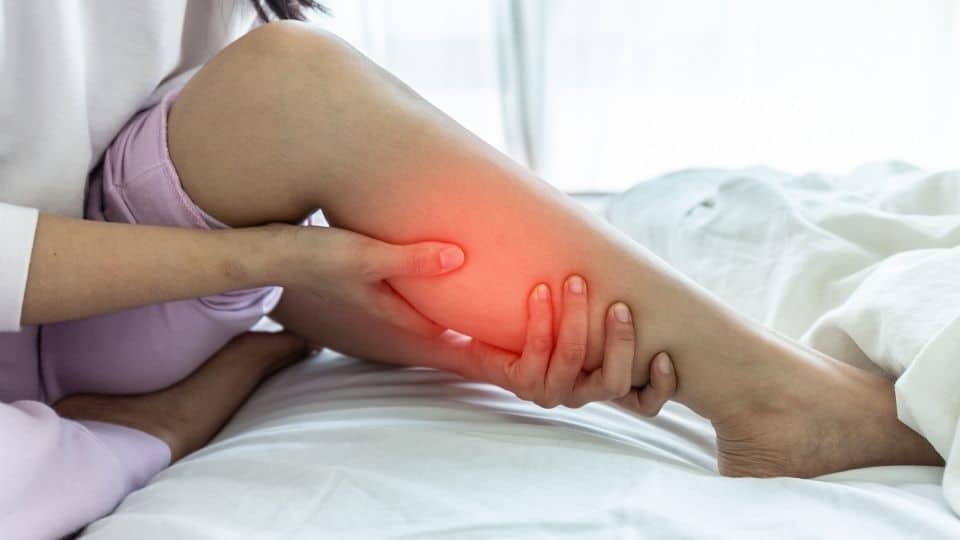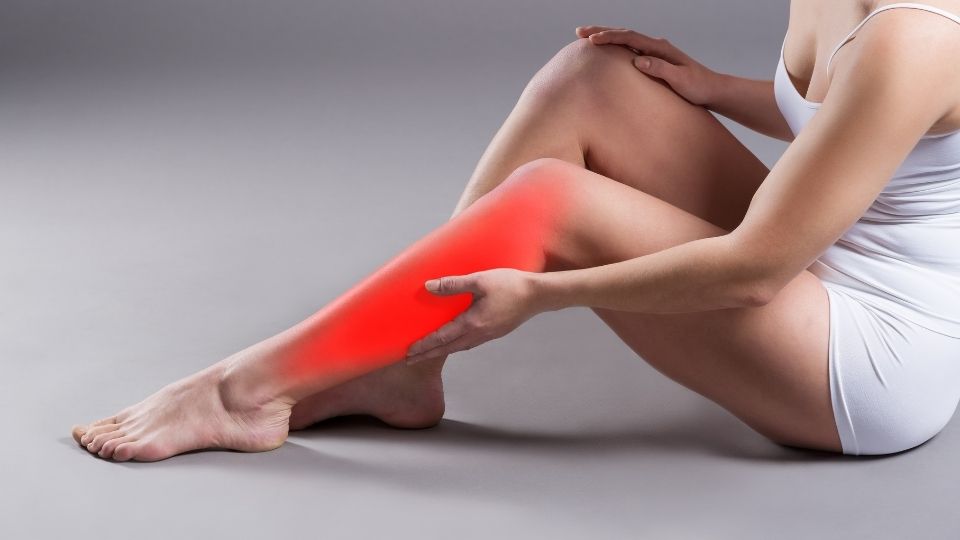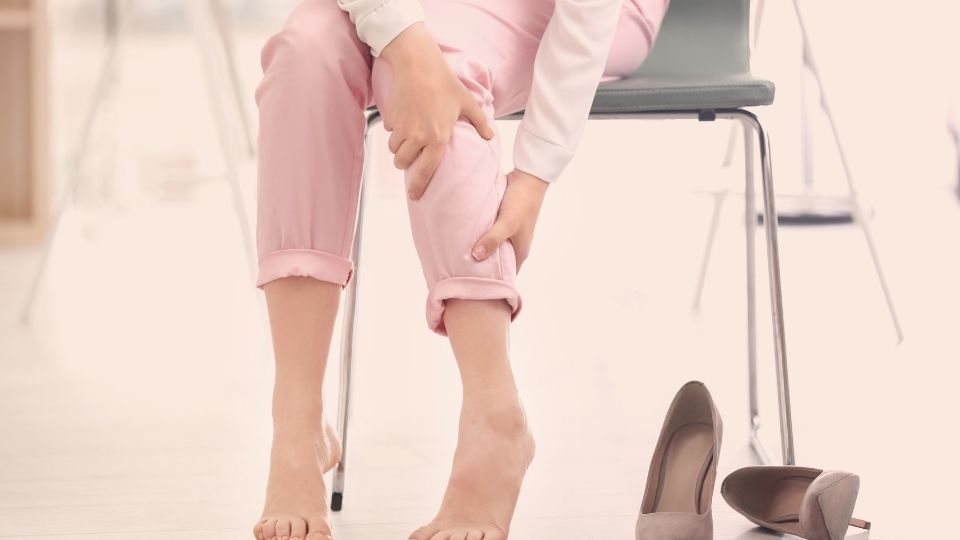Do your legs feel stiff and achy after sitting for a long time? You’re not alone. Many people experience leg pain after sitting, especially if they don’t move around often. In this blog post, we’ll explore some of the common causes of leg pain after sitting and offer some tips on how to alleviate the discomfort. Stay tuned!
As a general rule, legs hurt after sitting because prolonged inactivity can negatively affect your hip flexors, back, and posture. Sagging into a chair can cause compression of the discs in our spine, which will lead to degeneration and chronic pain.
In this article, I will give you reasons why your legs hurt after sitting. This will be founded on my 30 years of advising, treating patients facing similar challenges, researching, designing simple solutions (even a successful Kickstarter campaign!), and I even published a book about the topic.
How Do I Know if My Leg Pain Is Serious?
There are a few things you can look for to gauge how serious your leg pain may be. If the pain is accompanied by swelling, redness, or warmth in the affected area, it may be indicative of a more serious problem. Additionally, if the pain is severe enough to interfere with your ability to walk or put weight on your leg, it is also likely more serious. If you are experiencing any of these symptoms, it is best to see a doctor as soon as possible to get a proper diagnosis.
When Should I Be Concerned About Leg Pain

As a general rule, consider the following factors when determining if you should be concerned about your leg pain is serious. First, take note of where the pain is located. Is it in your calf, your thigh, or your knee? Second, consider how severe the pain is. Is it a dull ache or a sharp shooting pain? Third, think about how long you’ve been experiencing the pain. Is it a recent development or something you’ve been dealing with for a while?
Finally, ask yourself if the pain is impacting your ability to walk or bear weight. If the answer to any of these questions is “yes,” then you should consult a doctor to determine the cause of your leg pain and develop a treatment plan.
Best Tip for Leg Pain Relief After Prolonged Sitting?
Poor sitting posture is the most common cause of leg pain from sitting, according to my professional experience. Here is a simple solution that I recommend to my patients:
As you sit, you can move your spine into an optimal position while engaging your core muscles with an orthopaedic seat wedge. Isn’t that simple? Absolutely!

The solution is orthopedic seat wedges. By using a sitting wedge, you will have a better sitting surface, and your upper leg will be angled higher with your torso. With wedge chairs, you’ll still need to sit upright even though they provide a more comfortable sitting experience.
Orthopedic wedge cushions keep you seated upright when used correctly. The forward tilt enhances the inward curve in your lower spine. As you sit upright, the stress on your spine will be reduced, allowing your weight to be distributed naturally and preventing stress on joints, discs, and ligaments.
Best Cushion for Leg ComfortDoctor's Recommendation
Black Friday Offer!
Get 35% off Orthopedic Seat Cushion
Product DetailsResearch-based Design
Recommended ForBack Discomfort
Video Guide
Video Guide
What Are Painful Legs a Symptom Of?
There are many potential causes of painful legs, including muscle cramps, peripheral artery disease, and nerve damage. In some cases, leg pain may be a sign of a more serious condition, such as blood clots or infection. If you experience persistent or severe leg pain, you should see your doctor for an evaluation.
Does Leg Pain Indicate Heart Problems?
There are a few different ways that leg pain can be related to heart problems. One way is through peripheral artery disease (PAD). PAD occurs when there is a build-up of plaque in the arteries, which can limit blood flow to the legs. This can cause pain, cramping, or even numbness in the legs.

Another way that leg pain can be related to heart problems is through deep vein thrombosis (DVT). DVT is a condition in which a blood clot forms in the veins, and if it breaks free, it can travel to the lungs and cause a pulmonary embolism. While DVT can occur anywhere in the body, it is more likely to occur in the legs because of the increased blood flow and pressure in the veins there.
Finally, leg pain can also be a sign of a heart attack. This is because the heart muscle is not getting enough oxygen, which can cause pain in the chest that radiates down to the arms and legs. If you are experiencing leg pain, it is important to see a doctor determine the cause so that it can be treated appropriately.
Why Do Legs Hurt When Lying Down?
Generally speaking, when lying down, the legs hurt because blood flow slows down, and this causes blood to pool in the legs. Another reason is that the weight of the body pressing down on the legs can cause pain. A person with poor circulation or nerve damage may also experience leg pain when lying down.

Treatment for leg pain generally depends on the underlying cause. However, some simple measures that may help include elevating the legs while lying down, wearing compression stockings, and doing regular exercises to improve circulation.
When Should I Be Concerned About Leg and Foot Pain?
Generally, if you experience leg or foot pain that is severe, prolonged or interferes with your ability to walk or stand, you should consult a medical professional. Additionally, if you have any symptoms of an infection (e.g., redness, swelling, warmth, fever), consult a medical professional immediately.
Finally, if you have diabetes or another condition that causes decreased sensation in your feet, it is important to check your feet regularly for any signs of injury or ulceration.
What Does a Blocked Artery in the Leg Feel Like?
If you have a blocked artery in your leg, you may feel pain or cramping in your calf or thigh when walking or exercising. This is known as intermittent claudication. You may also have pain at rest, ulcers on your feet or toes, and changes in the color and temperature of your skin. If the blockage is severe, you may experience gangrene (tissue death) in your foot or leg. Treatment for a blocked artery in the leg typically involves lifestyle changes, medication, and surgery.
The symptoms of a blocked artery in your leg can include:
- – pain in your leg, often when you walk or exercise
- – cramping in your leg muscles
- – numbness or weakness in your leg
- – sores or ulcers on your leg that won’t heal
- – changes in the color of your skin on your leg
- – hair loss on your legs
- – shiny, thickened skin on your legs
What Are the Symptoms of a Blocked Artery in Your Leg?

As a general rule, the symptoms of a blocked artery in your leg can include pain, cramping, numbness, and weakness in the affected leg. You may also notice a change in color or temperature in the affected leg. If the blockage is severe, you may experience gangrene, which is a condition where the tissue in your leg dies due to a lack of blood flow.
What Is Vascular Leg Pain Like?
Vascular leg pain can feel like a dull, throbbing sensation or a sharp, stabbing pain. The pain is usually worse when you are standing or walking, and it may go away when you sit down or lie down. The pain may also get worse when you take a deep breath or cough. If the pain is severe, it may make it difficult for you to walk or even stand up.
What Causes Vascular Leg Pain?
There are several possible causes of vascular leg pain, including:
- Atherosclerosis: This is a condition in which plaque builds up on the walls of your arteries, making them narrower and less flexible. This can decrease blood flow to your legs and cause pain.
- Varicose veins: These are enlarged veins that can be seen just under the skin. They are common in the legs and can cause pain.
- Deep vein thrombosis: This is a condition in which a blood clot forms in one of the deep veins in your body, usually in the leg. This can cause pain and swelling.
- Peripheral artery disease: This is a condition in which plaque builds up on the walls of your arteries, making them narrower and less flexible. This can decrease blood flow to your legs and cause pain.
What Can I Do to Relieve Vascular Leg Pain?

There are several things you can do to relieve vascular leg pain, including:
- Elevate your legs: This will help decrease swelling and pain.
- Wear supportive stockings: These can help improve blood flow and reduce pain.
- Exercise: This can help improve blood flow and reduce pain.
- Quit smoking: This can help improve blood flow and reduce pain.
- Eat a healthy diet: This can help improve blood flow and reduce pain.
How Do You Get Rid of a Pain in Your Leg?
There are a few things you can do to try and get rid of a pain in your leg. Depending on the cause of the pain, some methods may work better than others. For example, if the pain is due to an injury, then resting and icing the area may be helpful. If the pain is due to a chronic condition, such as arthritis, then exercises or physical therapy may be more effective. Speak with your doctor about what treatment options are best for you.
Does a Blood Clot in the Leg Hurt All the Time?
As a general rule, a blood clot in the leg usually only causes pain when it first forms. After that, it may not cause any pain at all. A blood clot can cause chest pain and difficulty breathing if it breaks loose and travels to the lungs. If you have any concerns about your blood clot, please speak with your doctor.
What Does It Mean When Your Leg Hurts and You Can’t Walk?

There are many potential causes of leg pain, and it can be difficult to pinpoint the exact source of the pain. However, if the leg pain is accompanied by difficulty walking, it is likely due to a problem with the muscles, tendons, or joints in the leg.
Additionally, leg pain that is severe enough to interfere with walking may also be caused by problems with the circulatory system or nerves. If you are experiencing leg pain and difficulty walking, you should see a doctor for an evaluation.
Does Dehydration Cause Leg Pain?
Dehydration does not typically cause leg pain, but it can lead to other issues that may indirectly cause pain in the legs. For example, dehydration can cause cramps, which may cause leg pain. Additionally, dehydration can lead to low blood pressure, which can also lead to leg pain.
If you are experiencing leg pain, it is important to consult a medical professional to rule out any underlying causes. Treatment for dehydration generally involves consuming fluids and electrolytes. In severe cases, hospitalization may be necessary.
What Does Throbbing in Your Leg Mean?
In general, there are many potential causes of a throbbing sensation in your leg. One possibility is that you are experiencing muscle cramps, which can often occur after strenuous exercise or during periods of hot weather. If you have a blood clot in your leg, it is a serious medical condition that needs immediate attention.
If you are experiencing any other symptoms along with the throbbing sensation, such as pain, swelling, or redness, then you should see a doctor as soon as possible to rule out any other potential causes.
Does Diabetes Cause Leg Pain?
As a general rule, diabetes causes leg pain in different ways for every individual. However, it is generally believed that diabetes can cause leg pain due to the condition’s effect on blood circulation. Poor circulation can lead to nerve damage and other problems in the legs, which may in turn cause pain.
Additionally, diabetes may also cause inflammation in the joints, which can also contribute to leg pain. If you are experiencing leg pain and have diabetes, it is important to speak with your doctor to determine the best course of treatment.
How Long Does COVID Muscle Pain Last?
It is common for people to experience muscle pain after recovering from Covid-19. This type of pain can last for several weeks or even months. While the exact cause of this symptom is not yet known, it is thought that it may be due to inflammation in the muscles.
Treatment for this symptom typically includes over-the-counter pain medications and physical therapy. In most cases, the pain will eventually go away on its own. However, if the pain persists or gets worse, it is important to see a doctor for further evaluation.
What if I Am Unable to Sit Without Pain in the Buttocks?
If you’re experiencing pain in your buttocks, there are a few things you can do to help ease the discomfort. First, try sitting on a firm surface with a cushion or pillow for support. If that doesn’t help, try placing a heating pad on your buttocks for 10-15 minutes at a time. You can also try massaging the area to help loosen any tight muscles. If the pain is still not improving, it’s best to consult with your doctor or healthcare provider to rule out any other potential causes of the pain.
Summary
I hope that this blog post has been helpful and that you now have a better understanding of the causes of leg pain after sitting. If you experience these symptoms often, be sure to talk to your doctor about possible treatments. In the meantime, here are a few tips that might help alleviate the discomfort: 1) Get up and move around every hour or so; 2) Stretch regularly; 3) Use an orthopedic cushion when sitting for long periods of time. Enjoy the rest of your day!
Sources:
- Touliopolous, S. and Hershman, E.B., 1999. Lower leg pain. Sports medicine, 27(3), pp.193-204.
- Schäfer, A., Hall, T. and Briffa, K., 2009. Classification of low back-related leg pain—a proposed patho-mechanism-based approach. Manual therapy, 14(2), pp.222-230.
- Konstantinou, K., Dunn, K.M., Ogollah, R., Vogel, S. and Hay, E.M., 2015. Characteristics of patients with low back and leg pain seeking treatment in primary care: baseline results from the ATLAS cohort study. BMC musculoskeletal disorders, 16(1), pp.1-11.
- Edwards Jr, P.H., Wright, M.L. and Hartman, J.F., 2005. A practical approach for the differential diagnosis of chronic leg pain in the athlete. The American Journal of Sports Medicine, 33(8), pp.1241-1249.
- Libby, P., Ridker, P.M. and Maseri, A., 2002. Inflammation and atherosclerosis. Circulation, 105(9), pp.1135-1143.
- Weinmann, E.E. and Salzman, E.W., 1994. Deep-vein thrombosis. New England Journal of Medicine, 331(24), pp.1630-1641.
- Davoodi, L., Jafarpour, H., Taghavi, M. and Razavi, A., 2020. COVID-19 presented with deep vein thrombosis: an unusual presenting. Journal of investigative medicine high impact case reports, 8, p.2324709620931239.









